The Essential Guide to Skateboard Wax for Performance
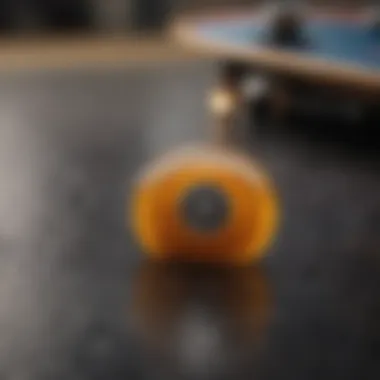
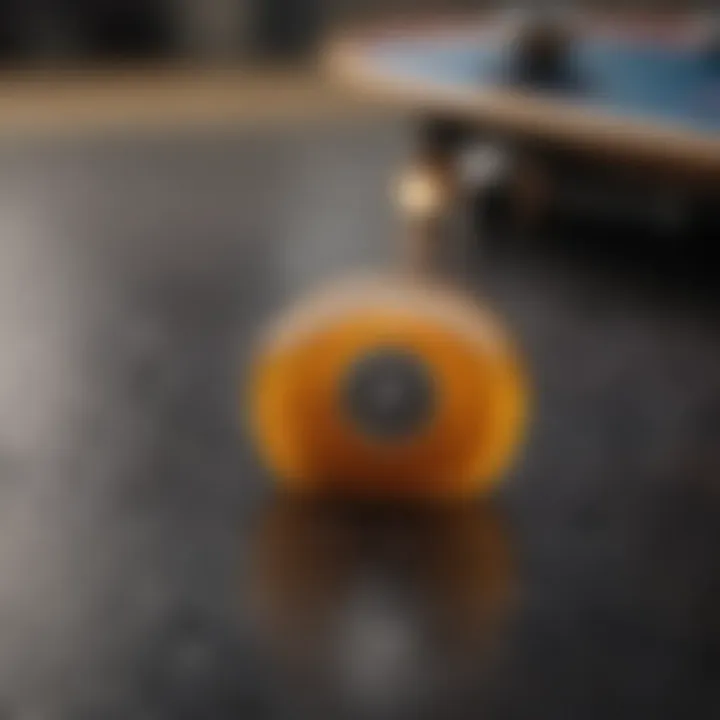
Intro
Skateboarding is more than just a pastime; it's a lifestyle that incorporates creativity, skill, and a bit of adrenaline. In this world of tricks, flips, and technical maneuvers, skateboard wax emerges as an unsung hero. While many enthusiasts focus on the board's design or the wheels' hardness, the importance of wax cannot be overstated. This article explores how wax can drastically enhance performance, prolong the lifespan of your board, and ultimately contribute to a smoother ride.
So, whether you’re a fresh-faced beginner looking to learn the ropes or a seasoned pro eager to refine your craft, understanding skateboard wax and its applications can change the game for you. Let's break this down deftly, diving deep into the waxes available today and how they fit into the larger skateboarding milieu.
Understanding Skateboard Wax
Skateboard wax might seem like just a minor detail in the grand scheme of skateboarding, but it carries a load of significance that many skaters—both green newcomers and seasoned veterans—often overlook. Understanding skateboard wax is a critical aspect of optimizing performance and enhancing the longevity of your board. It serves not merely as a slippery substance but as a crucial factor in the overall experience of skating.
Applying wax can enable skaters to glide more smoothly over obstacles or surfaces they encounter during tricks. It reduces friction, making it easier to execute complex maneuvers. Whether catching air off a ramp or grinding a rail, wax helps maintain momentum and control.
Additionally, investing time in understanding the properties and applications of wax can lead to greater satisfaction in your skateboarding journey. An informed choice regarding wax not only sharpens your performance but also prolongs the life of your skateboard. Benefits extend beyond the board; it enhances the connection between skater and craft as one learns to utilize wax effectively.
Definition and Purpose
Skateboard wax is essentially a lubricant that serves a specific purpose in the skating community. Its primary function is to reduce friction on surfaces, allowing skateboarders to execute tricks with greater ease. When applied strategically, it transforms rough and challenging obstacles into more skate-friendly terrains. The benefits are evident: wax lubricates the edges of your board, letting it slide smoothly across various surfaces, from ledges to coping.
Moreover, the right application of skateboard wax can help in mitigating wear and tear on both the skateboard and the surfaces being skated upon. It lowers the risk of damage to wooden ledges or concrete surfaces. Therefore, skateboard wax not only prolongs the quality of your tricks but also shows respect for the surroundings where you skate. It's a clever and pragmatic tool that every skater should keep in their arsenal.
Historical Context and Evolution
Looking back, the evolution of skateboard wax has its roots in the necessity for smoother rides and better performance. Early skateboarders experimented with various substances, from candle wax to paraffin, to achieve their goals. Initially, processes were rudimentary and access to suitable materials limited.
Over the years, as the sport grew, so did the technology behind skateboard wax. Manufacturers began developing specific wax formulations that catered to the needs of the skating community. Nowadays, we see a wide array of options available; paraffin-based wax, natural wax, and even synthetic formulas offer versatility and cater to different styles of skating.
The advancement did not happen overnight; revolutionary changes in materials science and a better understanding of friction allowed for innovations that significantly improved performance. Today’s skaters enjoy products specifically designed for different conditions, giving them the freedom to prepare their gear for various terrains. Thus, the skateboard wax available now reflects not just a product but a rich tradition that evolves hand-in-hand with the sport itself.
Types of Skateboard Wax
When it comes to skateboarding, one crucial element that can dictate the smoothness of your ride is the type of wax you choose to use. Understanding the various types of skateboard wax is not just about picking a random stick off the shelf; it’s about optimizing your skating experience, enhancing your performance, and getting the most out of your investments in gear. Skateboard wax can drastically reduce friction on surfaces, thus providing slicker grinds and slides, which is a must for any serious skater.
Paraffin-based Wax
Paraffin-based wax is often the go-to choice for many skateboarders. This type of wax is derived from petroleum products and is known for its excellent compatibility with numerous surfaces including metal and concrete. One of the standout features of paraffin wax is its ability to provide a long-lasting, smooth finish that persists through numerous skate sessions.
If you are a skater looking to nail those technical tricks, this wax type may cater well to your needs due to its low melting point, allowing it to coat surfaces effectively without creating a big mess. However, keep in mind that the downside of paraffin-based wax is that it may not last as long on rough or abrasive surfaces.
Natural Wax
Natural wax options are making waves in the skateboarding community, particularly among environmentally conscious skaters. This type of wax is typically made from organic materials such as beeswax or soy. One of the key benefits of natural wax is its eco-friendliness; it breaks down more easily in the environment than synthetic options.
Natural wax tends to offer a slightly different grip due to its unique formulation, which might alter how tricks feel underfoot. Some skaters appreciate the softer, almost buttery feel of natural wax when they slide or grind—perfect for those who prioritize both performance and sustainability.
Synthetic Wax
Synthetic wax is a more modern and advanced option, often formulated with a mix of chemicals designed to enhance performance on different surfaces. Skaters who opt for synthetic wax usually find that it retains its slickness over time better than natural or paraffin wax. One key characteristic of synthetic wax is its ability to withstand varying temperatures, making it a solid choice for those who skate in different environments.
However, it's pertinent to consider that synthetic wax may not be as environmentally friendly and can sometimes carry a slightly higher price tag. Thus, while it may excel in performance, the implications for the planet should be thought about carefully.
Specialty Wax Variants
Specialty wax variants are where things get creatively interesting. These waxes serve niche needs and often have unique features that catch the eye of many skaters.
Flavored Wax
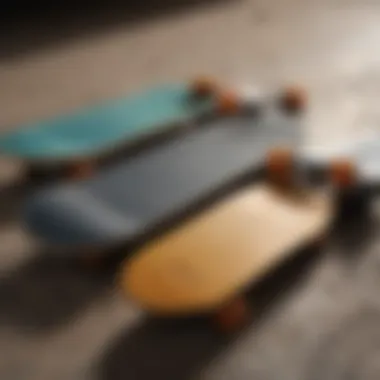
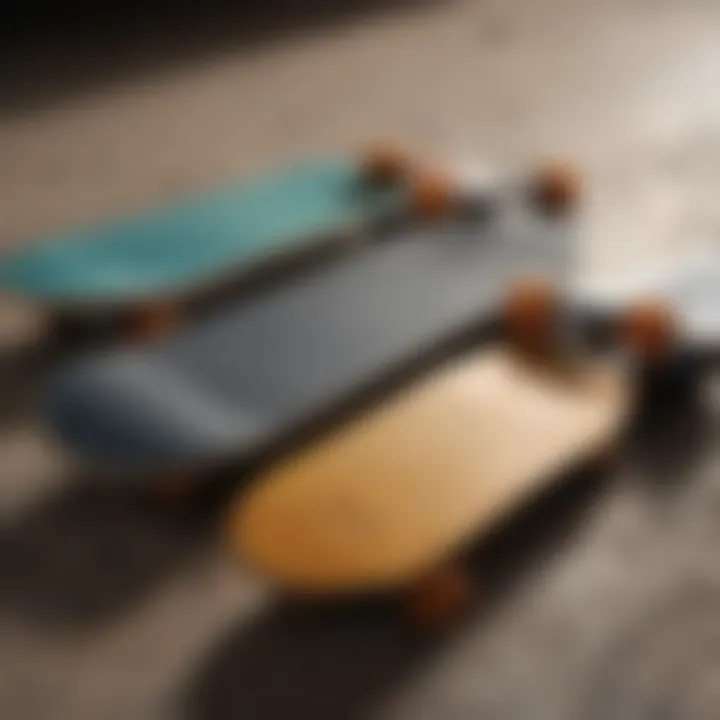
Flavored wax brings a fun twist to the typical skateboarding experience. While it doesn't necessarily improve performance, the scent can be refreshing, making your session more enjoyable. The key characteristic of flavored wax is, unsurprisingly, its pleasant aroma, which can give the mundane act of waxing your board a bit of flair.
While not every skater appreciates the idea of scented wax—some might consider it a gimmick—the fun aspect adds personal flavor (pun intended) to the sport. However, do note that the chemical scent might wear off quicker, leaving you with the regular wax experience soon after application.
Glow-in-the-Dark Wax
Glow-in-the-dark wax holds a distinct allure, particularly for those who enjoy skating under the stars. Its major attribute is its ability to glow after absorbing light, creating a visual spectacle that deters nighttime skating from being mundane. Beyond aesthetic appeal, it can be beneficial in low-light conditions, allowing skaters to see their tricks from afar.
One advantage of this wax is that it helps with visibility and, in some cases, can even serve as a conversation starter among fellow skaters. On the flip side, it may not perform as well in terms of longevity compared to more traditional wax types, and skaters might find themselves reapplying it more frequently.
"Choosing the right wax can be a game changer. It's not just a formality; it builds a seamless connection between you and your board."
In summary, each type of skateboard wax carries unique benefits and considerations that can significantly impact your ride. Whether you're in pursuit of sustainability with natural wax, durability with synthetic options, or just looking to have some fun with flavored or glow-in-the-dark varieties, understanding these nuances ensures you're well-equipped for an optimal skating experience.
The Science Behind Skateboard Wax
Understanding the science that underpins skateboard wax is crucial for anyone looking to optimize their riding experience. Wax isn’t just a simple substance; it’s engineered for specific outcomes that significantly influence performance. When skateboarders wax their boards, they’re engaging in a nuanced process that enhances both the usability and durability of the skateboard. This section will delve into two main areas: how wax reduces friction and how it interacts with different materials to extend longevity.
Friction Reduction Mechanism
At its core, skateboard wax serves primarily to reduce friction between the skateboard deck and the surfaces skaters often interact with, such as ledges, rails, or bowl coping. The friction reduction mechanism operates on the principle of creating a slick surface. In simpler terms, when you apply wax to your skateboard, you create a barrier that minimizes the contact between the wheels or the board and the surface.
- Hydrophobic Properties: One of the key elements at work here is the hydrophobic nature of many waxes, especially those derived from paraffin. This means that when liquid comes in contact with a waxed surface, it's less likely to stick or create unwanted drag. In turn, this allows the skateboard to slide smoothly, thereby enhancing trick execution.
- Molecular Structure: The chemical composition of the wax allows for a smoother sliding experience. The long chains of hydrocarbons in paraffin or synthetic waxes mean that they can easily glide over obstacles. It's like comparing a well-oiled machine to a rusty one.
This friction reduction mechanism is integral to successfully completing tricks and minimizing the risk of falls. Experienced skaters often comment that finding the right wax can be game-changing, leading them to level up their skills.
Longevity and Material Interaction
The interaction between skateboard wax and various materials affects not just sliding performance, but also the lifespan of both the wax and the skateboarding surface. When applied correctly, wax can serve as a protective agent, allowing skates to last longer before needing maintenance. Let’s unpack this further.
- Wear and Tear: The right wax protects the skateboard deck itself from harsh surfaces. Skaters who frequently grind or slide will find that a suitable wax diminishes the scraping damage that can accumulate over time, keeping the skateboard looking and performing better.
- Material Compatibility: Understanding material compatibility is also vital. For instance, a wax meant for wooden surfaces may differ significantly from what one would use on metal or concrete. Each surface reacts differently with wax. Therefore, skaters should take into account the type of obstacle they frequently ride on.
- Reapplication: The material interaction is also linked to the wear characteristics of different waxes. Some might fade quickly due to aggressive use, while others can endure longer sessions. Recognizing when to reapply wax without allowing too much deterioration can keep a skater's setup in prime condition.
In essence, understanding the science behind skateboard wax is about more than just maintaining the board; it's about enhancing the overall skating experience. The ability to reduce friction and interact efficiently with various materials plays a significant role in how well a skater can perform. Reaping these benefits requires awareness, expertise, and experimentation, aiming for that smooth and reliable glide that all skaters crave.
Application Techniques
Applying skateboard wax properly can make all the difference in how your board performs. With the right technique, skaters can reduce friction, enhance slide quality, and prolong the life of their equipment. It's not just slapping some wax on the curb and hoping for the best; there's a method to this process, and understanding it can elevate your ride.
Preparing the Surface
Before diving into the waxing itself, you need to prep the surface like a chef preps ingredients. A clean surface leads to a better bond between the wax and the skateboard. Start by inspecting the area where you plan to skate and waxing. Whether it’s a ledge or a rail, remove any dirt, grime, or debris with a cloth or a soft brush. If you see rust or any severe damage, take a moment to address that, too.
Now, let’s not sugarcoat this: dirt and wax aren’t friends. If you skip the cleaning step, the wax won't adhere well. Think of it like trying to bake a cake in a dirty pan—just won’t turn out right!
"Waxing without preparing the surface properly is like trying to run with one shoe on."
Proper Waxing Methodology
Now, let’s talk about the actual application of the wax. Grab your favorite wax stick—whether it's paraffin-based, natural, or synthetic—the choice is yours. To wax effectively, hold the stick at a slight angle and begin to apply a thin, even layer, moving in one direction. Don’t glob it on thick, or you'll end up with a gooey mess that can attract dirt.
Tips for Application:
- Even Pressure: Maintain the same pressure throughout to avoid uneven patches.
- Work in Sections: Small sections are better. Focus on one area at a time, such as the edge of a ledge or the crest of a rail.
- Use Heat Wisely: For some wax types, a little heat can help them spread more evenly. If you’re using a lighter wax, briefly heat it with a lighter (take care not to burn yourself!) or the sun if it’s a nice day.
- Finishing Touches: After applying wax, you can lightly tap with a skate tool to smoothen any peaks or bumps.
In applying wax skillfully, you'll find your board slides nicer, meaning more successful tricks and flips. Paying attention to your technique not only enhances performance but can also ignite a passion for the art of skating itself.


Thus, mastering these application techniques will turn a simple mundane task into a key part of your skateboard maintenance routine, ensuring optimal performance whenever you hit the streets.
Maintenance and Care
When it comes to skateboarding, many enthusiasts focus on the tricks, the boards, or even the shoes. However, the importance of maintaining your skateboard wax shouldn't be overlooked. Effective maintenance and care of your skateboard wax can significantly enhance your riding experience. Skateboard wax not only improves the surfaces you skate on but also affects how you perform. As any seasoned skater will tell you, a well-waxed board can be the difference between a smooth ride and a frustrating one. Taking time to care for your wax ensures that you are always ready for a quick run and extends the life of your skateboard.
Recognizing Wax Wear
Understanding when your wax needs reapplication is crucial. Just like how skaters feel the difference when their wheels are worn out, the same goes for wax. One of the common signs is the loss of that slick feel when you slide over a ledge or rail. You might notice a rougher surface where the wax has thinned out. If you find your tricks aren’t flowing as they used to, or you hear a screech instead of a smooth glide, it could be time to inspect your board.
Here are some tell-tale signs that your wax is calling for a refresh:
- Visual Inspection: Look closely; if you see dry patches or uneven surfaces, you've probably hit the point of no return.
- Tactile Feedback: Run your fingers over the area; if it feels gritty, then your wax has lost its potency.
- Performance Decline: If you're bailing more on grind tricks or that sweet slide has turned into a struggle, this can also indicate wax wear.
Best Practices for Reapplication
Reapplying wax isn’t just a slapdash job; there’s a method to it. Following certain best practices makes all the difference in ensuring that your wax does its job effectively.
- Start Fresh: Before applying new wax, it’s good to scrape off any old remnants using a razor or similar tool. A clean slate guarantees even application.
- Choose Your Wax Wisely: Depending on your skating surface, select the right type of wax. For example, paraffin-based wax works well in most general scenarios, while flavored or glow-in-the-dark variants add a touch of style and distinction.
- Even Application: When you begin waxing, apply an even layer across the desired surfaces. Too much can make a slippery mess; too little won't help at all.
- Heat It Up: For a stronger bond, consider warming the wax slightly before application. This can increase the adhesion and longevity of the wax.
- Give It Time: After applying, allow the wax to set for a little while before hitting the skatepark. Patience goes a long way in maximizing the benefits of your reapplication.
By knowing when your wax is worn out and following these best practices for reapplication, you'll keep your sessions smooth and enjoyable. Remember, a little diligence in maintenance can help you land that next big trick with style and grace. The right care will elevate not only your board's performance but also your confidence as you take on new challenges.
User Experiences and Testimonials
User experiences and testimonials serve a critical role in our understanding of skateboard wax and its impact on performance. When it comes to optimizing your ride, who better to provide insight than those who have been hitting the pavement day in and day out?
Hearing from seasoned riders and beginners alike brings a wealth of knowledge, illuminating aspects that technical specifications alone can miss. Personal experiences reflect the nuances of riding style, technique, and preference, making them invaluable.
"Wax is not just an accessory; it’s part of my whole skating experience. The right wax can turn a frustrating trick into a moment of pure flow." — A passionate skater
When you dive into these stories, you find a mix of joy, frustration, and learning. They reveal common pitfalls, effective techniques, and the many ways in which different types of wax have transformed rides. This section is not just about what’s written on product labels; it’s about what happens on the ground, where the wheels meet the surface.
Seasoned Skaters' Perspectives
For many seasoned skaters, the learning curve regarding wax has been steep. These veterans have spent countless hours experimenting with various wax types, using what they call a ‘trial and error’ method to find what fits their unique style.
In their discussions, often what comes through is how crucial it is to align wax choice with skateboarding environment. For example, a skater who often rides in urban areas with gritty surfaces may swear by synthetic options that resist dirt and grime buildup, while someone who skates at a local park might favor natural wax for its smooth application and easy reworkability.
Additionally, seasoned skaters recognize that their technique impacts their wax choice. Those focusing on grind-heavy routines often prefer a harder wax that lasts longer, while skaters who emphasize flip tricks may opt for softer wax that allows for a quicker application for a slicker finish.
Overall, the conversations revolve around how personal experiences can radically change the perception of what ‘best’ really means in the world of wax.
Beginner Insights
While beginners may not have the same depth of experience as their seasoned counterparts, their insights are no less valuable. Sales at local skate shops often skyrocket during events where skaters gather, and it's the fresh perspective of newcomers that brings a lively energy to the community. Their journey typically starts with a basic understanding of why waxing is essential, but as they apply it themselves, a host of revelations unfold.
One common observation among beginners is the importance of learning from more experienced skaters. Watching those who have mastered the craft often leads to a transformative learning experience. They quickly understand that not all wax is created equal, and what works for one trick may not work for another.
Beginner skaters often share stories about their first attempts at skating and the role of wax in improving their confidence. For instance, on their first trip to the skate park, a rookie may have struggled with ollies but noticed a significant difference after a session of applying wax to curbs and ledges. That simple act can elevate the ride and encourage them to attempt bolder tricks.
Ultimately, the insights from beginners highlight the importance of community engagement. Emphasizing questions, shared experiences, and friendly rivalries introduces them to a learning curve steeped in camaraderie.
The Impact of Skateboard Wax on Performance
Skateboard wax is not just a trivial accessory; it plays a pivotal role in enhancing a skateboard’s performance. For skateboarders at all levels, understanding how wax can influence their ride is essential. Wax improves not just the functionality of the skateboard but also the overall experience while riding. Given the variety of terrains and surfaces skaters encounter, using the right skateboard wax ensures maximized trick execution and a polished glide.
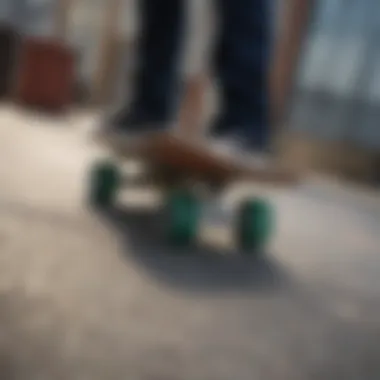
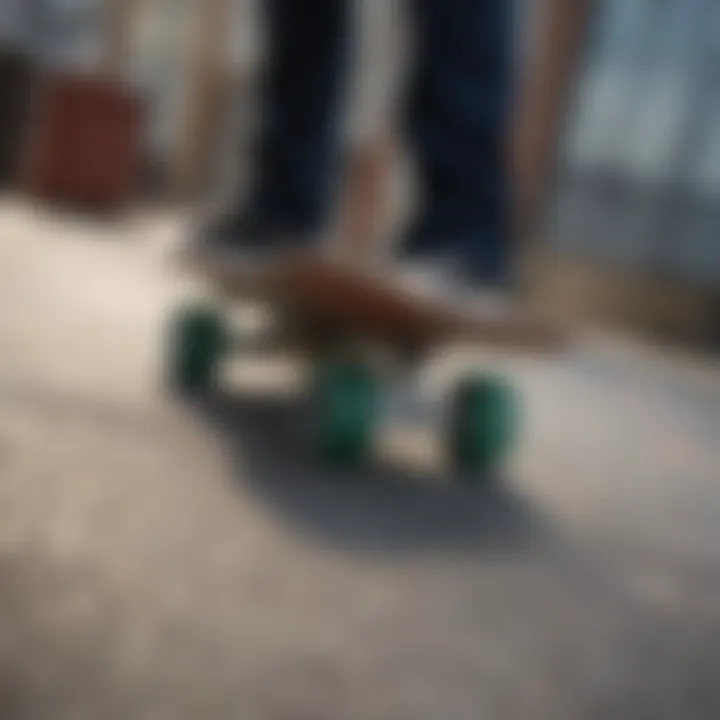
Enhancing Trick Execution
When it comes down to executing tricks, skateboard wax can make the difference between a smooth ride and a frustrating fall. Flat surfaces or ledges can often present a challenge due to the friction between the skateboard and the surface. Applying a proper coat of wax reduces this friction, enabling smoother grinds and slides. A well-waxed spot allows skaters to focus solely on their technique rather than worrying about the board getting stuck.
- Better Grip and Slide: Wax contributes to a balance of grip and slide. While skaters want to maintain traction for pops, they also need to slide effortlessly during grinds. This synthesis is crucial for more advanced tricks, where tech and speed come together.
- Increased Trick Variety: As skateboarders become comfortable with waxed surfaces, they are likely to push their limits with more challenging tricks. This enhanced flair not only makes the individual skater look more skilled but also increases their creativity in developing new maneuvers.
Influence on Overall Ride Quality
The overall quality of a rider's experience can be greatly influenced by the application of skateboard wax. A thoughtfully chosen and applied wax can notably change how a skateboard feels beneath one's feet. It's not merely a matter of speed; the whole sensation of riding transforms.
- Smoother Transition: Wax creates a buttery feel on surfaces, which allows for smoother transitions between tricks. Skaters often find themselves flowing naturally between various moves rather than struggling to regain footing.
- Confidence Boost: When riders know that their gear is optimal, their confidence rises. Such confidence not only encourages skaters to push boundaries but also contributes to safer, more calculated moves.
"A well-waxed board feels like an extension of your body. Missing that element makes every trick feel like a gamble."
Economic Considerations
Understanding the economic aspects of skateboard wax is crucial for both beginners and seasoned skaters who wish to balance performance and budget. In the skateboarding world, while skill and technique reign supreme, the equipment you use — including wax — can significantly influence your ride and overall experience. Choosing the right type of wax not only enhances performance but can also affect how often you need to replace it and, consequently, your spending habits.
Among skaters, there is a common saying: "Cheap wax can cost you." This phrase often rings true when considering not just the price tags but also how those choices play into a skater's performance longevity and enjoyment. A well-waxed board can empower a skater to land tricks successfully, leading to fewer falls and, in turn, potentially reducing the need for repairs or replacements on gear that gets banged up more without proper maintenance.
Ultimately, making informed decisions regarding skateboard wax involves weighing initial costs against long-term benefits, factoring in usage patterns, surface conditions, and personal skill levels.
Cost Analysis of Different Wax Types
The cost of skateboard wax can vary greatly depending on the type of wax you choose. This analysis digs deeper into the prices for various wax types, allowing skaters to see what fits their financial plans best.
- Paraffin-based Wax: Typically falling in the lower price range, this is often the go-to choice for many skaters. It works well for general use and is widely available, making it a cost-effective choice for those who skate often.
- Natural Wax: While slightly pricier due to its organic materials, many skaters prefer it because of its eco-friendliness. This type of wax delivers decent performance, promoting an environmentally conscious approach to skating.
- Synthetic Wax: Generally, this is on the higher end of the pricing spectrum. However, its longevity and performance can justify the cost for competitive skaters who demand top-notch results.
- Specialty Wax Variants: Fragrant and glow-in-the-dark waxes often carry a premium label, appealing to those seeking something extra or unique. While their performance isn’t always superior to more straightforward options, they do add a fun flair to the riding experience.
In essence, knowing the costs associated with each type helps skaters decide how to allocate their budgets wisely while still maximizing their performance.
Long-term Investment in Performance
Investing in the right skateboard wax should be seen not just as a purchase but as a strategic decision impacting performance over time. When you invest in high-quality wax that suits your style of skating, you often find it pays off in the end, as good wax enhances maneuverability and grip. This can lead to better trick execution, ultimately making the investment worthwhile.
When thinking about long-term value, consider these aspects:
- Durability: Good wax tends to last longer, meaning fewer applications are needed over time. This reduces the frequency at which you must make new purchases.
- Performance Boost: A well-maintained board enhances not only your skill level but also reduces the physical strain on your body from more frequent falls.
- Customization: Higher-end waxes often allow for a more tailored skating experience, as they can complement specific skill sets and terrain types.
Sustainability and Environmental Impact
In recent years, the conversation regarding sustainability has reached all corners of the world, including the skateboarding community. The significance of sustainable practices cannot be overstated, especially in a sport where materials can pose a threat to our environment. This section scrutinizes how skateboard wax affects not just the performance of skaters, but the planet as well.
Choosing eco-friendly wax options is vital, as traditional wax can be derived from petroleum-based sources; this isn't friendly to the earth. By making a conscious decision, skaters can actively contribute to a healthier environment. Moreover, embracing sustainable materials aligns with a growing ethos that values eco-awareness—something increasingly important to younger generations in today’s eco-conscious culture.
The long-term benefits are significant; if skaters opt for sustainable wax, they can help minimize the ecological footprint of their sport. This isn’t just about individual choices, but rather the collective impact that can arise when communities unite with a common goal. Now, let’s examine some options and best practices in detail.
Eco-friendly Wax Options
When it comes to choosing eco-friendly wax, options are becoming more prominent in the market. Many companies are stepping up to invent products that allow users to shred without burdening Mother Earth.
- Organic Plant-based Waxes: These waxes are derived from natural resources such as vegetable oils. They not only reduce pollution but also offer great performance.
- Beeswax: Sourced from bees, this natural wax provides excellent grip and longevity, allowing skaters to slide smoothly on their boards. It’s fully biodegradable and comes from a sustainable resource.
- Soy Wax: Made from soybeans, this kind of wax is rapidly renewable and offers a similar consistency to traditional wax, but it's much friendlier to the earth.
Not to mention, switching to these green options isn’t just about sustainability; performance can be comparable to or even exceed conventional products.
Responsible Disposal Practices
The manner in which we dispose of skateboard wax can significantly impact the environment. Even if one opts for eco-friendly wax, the act of disposal requires thoughtfulness. Improper disposal can lead to contamination of soil and water, which obviously is counterproductive to the goal of sustainability.
Best Practices for Disposal:
- Recycling programs: Some localities offer recycling for certain types of wax. Check your community’s guidelines.
- Dedicated bins for used wax: Make sure to have designated places where wax can be thrown away responsibly. Some shops offer wax recycling too.
- Avoid waste: Be mindful about the amount of wax you use. Applying only what’s necessary can reduce the leftover waste significantly.
An informed and responsible approach can help mitigate skateboard wax's ecological impact over time. Each small step contributes to a larger movement toward sustainability in the sport, inspiring the next wave of skaters to take care of our planet while perfecting their tricks.







